Which of the following statements about species, as defined by the biological species concept, is (are) correct?
- Biological species are defined by reproductive isolation.
- Biological species are the models used for grouping extinct forms of life.
III. The biological species is the largest unit of population in which successful interbreeding is possible.
- A) I and II
- B) I and III
- C) II and III
- D) I, II, and III
B
There is still some controversy among biologists about whether Neanderthals should be placed within the same species as modern humans or into a separate species of their own. Most DNA sequence data analyzed so far indicate that there was probably little or no gene flow between Neanderthals and Homo sapiens. Which species concept is most applicable in this example?
- A) phylogenetic
- B) ecological
- C) morphological
- D) biological
A
You are confronted with a box of preserved grasshoppers of various species that are new to science and have not been described. Your assignment is to separate them into species. There is no accompanying information as to where or when they were collected. Which species concept will you have to use?
- A) biological
- B) phylogenetic
- C) ecological
- D) morphological
D
Two species of frogs belonging to the same genus occasionally mate, but the offspring fail to develop and hatch. What is the mechanism for keeping the two frog species separate?
- A) the postzygotic barrier called hybrid inviability
- B) the postzygotic barrier called hybrid breakdown
- C) the prezygotic barrier called hybrid sterility
- D) the prezygotic barrier gametic isolation
A
Dogs (Canis lupus familiaris) and gray wolves (Canis lupus) can interbreed to produce viable, fertile offspring. These species shared a common ancestor recently (in geologic time) and have a high degree of genetic similarity, although their anatomies vary widely. Judging from this evidence, which two species concepts are most likely to place dogs and wolves together into a single species?
- A) ecological and phylogenetic
- B) morphological and phylogenetic
- C) biological and morphological
- D) biological and phylogenetic
D
Which of the following statements about speciation is correct?
- A) The goal of natural selection is speciation.
- B) Natural selection chooses the reproductive barriers for populations.
- C) It always takes millions of years for speciation to occur.
- D) Speciation is a basis for understanding macroevolution.
D
Which of the following criteria used in classification is the most easily evaluated by the observer?
- A) morphology
- B) biochemistry
- C) physiology
- D) DNA sequence
A
A species is a member of a group called a population,
- A) whose members have the ability to interbreed and produce viable, fertile offspring.
- B) whose members have the ability to interbreed but do not produce viable offspring.
- C) which are reproductively incompatible.
- D) which are distinct biological species that live in the same area.
A
Which of the following reproductive types of isolation illustrates postzygotic barriers?
- A) habitat isolation
- B) mechanical isolation
- C) temporal isolation
- D) hybrid breakdown
D
The phylogenetic species concept defines a species as
- A) the smallest group of individuals that share a common ancestor.
- B) an ecological niche, interacting with living and nonliving parts of their environment.
- C) a body shape and other structural features.
- D) a reproductive isolation.
A
Which species concept occurs in the presence of gene flow?
- A) morphological
- B) biological
- C) ecological
- D) phylogenetic
C
Rocky Mountain juniper (Juniperus scopulorum) and one-seeded juniper (J. monosperma) have overlapping ranges. If pollen grains (which contain sperm cells) from one species are unable to germinate and make pollen tubes on female ovules (which contain egg cells) of the other species, then which of these terms are applicable?
- sympatric species
- prezygotic isolation
- postzygotic isolation
- allopatric species
- habitat isolation
- reduced hybrid fertility
- A) 1 and 2
- B) 2 and 4
- C) 1, 3, and 6
- D) 2, 4, and 5
- E) 1, 2, 5, and 6
A
In a hypothetical situation, a certain species of flea feeds only on pronghorn antelopes. In rangelands of the western United States, pronghorns and cattle often associate with one another. If some of these fleas develop a strong preference for cattle blood and mate only with other fleas that prefer cattle blood, then over time which of these should occur, if the host mammal can be considered as the fleas' habitat?
- reproductive isolation
- sympatric speciation
- habitat isolation
- prezygotic barriers
- A) 1 only
- B) 2 and 3
- C) 1, 2, and 3
- D) 2, 3, and 4
- E) 1 through 4
E
Among known plant species, which of these are the two most commonly occurring phenomena that have led to the origin of new species?
- allopatric speciation
- sympatric speciation
- sexual selection
- polyploidy
- A) 1 and 3
- B) 1 and 4
- C) 2 and 3
- D) 2 and 4
D
The origin of a new plant species by hybridization, coupled with accidents during cell division, is an example of
- A) allopatric speciation.
- B) sympatric speciation.
- C) autopolyploidy.
- D) habitat selection.
B
The most likely explanation for the high rate of sympatric speciation that apparently existed among the cichlids of Lake Victoria in the past is
- A) sexual selection.
- B) habitat differentiation.
- C) polyploidy.
- D) pollution.
- E) introduction of a new predator.
A
More species are found on subdivided areas due to
- A) geographic isolation.
- B) absence of geographic isolation.
- C) gene flow.
- D) gene drift.
A
After geographic separation, what process would be the last step before reproductive isolation?
- A) gene pool divergence
- B) mutation
- C) natural selection
- D) genetic drift
C
How can reproductive barriers form between sympatric populations while their members stay in contact with them?
- A) increased gene flow
- B) increased polyploidy
- C) decreased habitat differentiation
- D) decreased sexual selection
B
Which of the following descriptions of polyploidy indicate speciation?
- A) An accident during cell division results in an extra set of chromosomes.
- B) An individual has more than two chromosome sets from a single species.
- C) Two different species interbreed and produce hybrid offspring.
- D) Allopolyploids mate with each other but cannot interbreed with parent species.
D
Which one of the following choices describes an advantage of the biological species concept?
- A) lack of methodology to evaluate fossil reproduction
- B) does not apply to organisms that reproduce asexually
- C) overemphasizes absence of gene flow
- D) describes speciation by the evolution of reproductive isolation
D
"Conventional wisdom holds that the development of separate species happens quickly, most often when populations become separated by a geographical barrier." This is called ________ speciation. "Even if these groups meet again and manage to mate before diverging too far from one another, their offspring will be unfit and die out." This is described as hybrid ________.
- A) sympatric; viability
- B) allopatric; fertility
- C) sympatric; breakdown
- D) allopatric; breakdown
D
Which of these phrases describes a stable hybrid zone?
- A) obstacle to gene flow
- B) reduced hybrid viability
- C) reduced hybrid fertility
- D) continued production of hybrid individuals
D
Which mechanism would reverse speciation?
- A) increased gene flow
- B) gene pools of the two species becoming increasingly different
- C) increased ability of females to discriminate mates
- D) decreased production of hybrids
A
Sexual selection in cichlids occurs by female mate choice and results in reproductive isolation when
- A) subpopulations exploit a habitat not used by the parent population.
- B) under normal light, each species prefers males of their own species.
- C) all species have extra sets of chromosomes.
- D) under orange light, each species prefers orange mates.
B
A hybrid zone is properly defined as
- A) an area where two closely related species' ranges overlap.
- B) an area where mating occurs between members of two closely related species, producing viable offspring.
- C) a zone that features a gradual change in species composition where two neighboring ecosystems border each other.
- D) a zone that includes the intermediate portion of a cline.
- E) an area where members of two closely related species intermingle, but experience no gene flow.
B
Which of these should decline in hybrid zones where reinforcement is occurring?
- A) gene flow between distinct gene pools
- B) speciation
- C) the genetic distinctness of two gene pools
- D) mutation rate
- E) hybrid sterility
A
The most likely explanation for the recent decline in cichlid species diversity in Lake Victoria is
- A) reinforcement.
- B) fusion.
- C) stability.
- D) geographic isolation.
B
A narrow hybrid zone separates the toad species Bombina bombina and Bombina variegata. What is true of those alleles that are unique to the parental species?
- A) Such alleles should be absent.
- B) Their allele frequency should be nearly the same as the allele frequencies in toad populations distant from the hybrid zone.
- C) The alleles' heterozygosity should be higher among the hybrid toads there.
- D) Their allele frequency on one edge of the hybrid zone should be roughly equal to their frequency on the opposite edge of the hybrid zone.
C
Which of the following activities occurs first in order to begin speciation?
- A) single gene change
- B) formation of mechanical barrier to reproduction
- C) postzygotic hybrid sterility in Drosophila
- D) interruption of gene flow between two populations
D
Mechanism of macroevolution works by
- A) multiple acts of speciation on an ancestral organism.
- B) continuation of gene flow between populations.
- C) weakening of barriers to reproductive isolation.
- D) appearing in the fossil record of species with similar morphologies.
A
Rocky Mountain juniper (Juniperus scopulorum) and one-seeded juniper (J. monosperma) have overlapping ranges. If pollen grains (which contain sperm cells) from one species are unable to germinate and make pollen tubes on female ovules (which contain egg cells) of the other species, then which of these terms is applicable?
- A) behavioral isolation
- B) mechanical isolation
- C) hybrid breakdown
- D) reduced hybrid viability
B
Speciation
- A) occurs at such a slow pace that no one has ever observed the emergence of new species.
- B) occurs only by the accumulation of genetic change over vast expanses of time.
- C) must begin with the geographic isolation of a small, frontier population.
- D) occurs when one species splits into two or more species.
D

In which habitat should one find snapping shrimp most closely related to shrimp that live in habitat A4?
- A) A3
- B) A5
- C) B4
- D) either A3 or A5
- E) any species from any one of the side A habitats
C

Which of these habitats is likely to harbor the youngest species?
- A) A5
- B) B4
- C) A3
- D) B2
- E) A1
E

Which habitats should harbor snapping shrimp species with the greatest degree of genetic divergence from each other?
- A) A1 and A5
- B) A1 and B5
- C) B5 and B1
- D) A5 and B5
- E) Both A1/A5 and B1/B5 should have the greatest, but equal amounts of, genetic divergence.
D

Which factor is most important for explaining why there are equal numbers of snapping shrimp species on either side of the isthmus?
- A) the relative shortness of time they have been separated
- B) the depth of the ocean
- C) the number of actual depth habitats between the surface and the sea floor
- D) the elevation of the isthmus above sea level
- E) the depth of the canal
A
There are currently two large, permanent bridges that span the Panama Canal. The bridges are about 8 miles apart. If snapping shrimp avoid swimming at night and avoid swimming under shadows, then what do these bridges represent for the snapping shrimp?
- A) sources of refuge
- B) geographic barriers
- C) sources of a hybrid zone between the two bridges
- D) sources for increased gene flow
B
The Panama Canal was completed in 1914, and its depth is about 50 feet. After 1914, snapping shrimp species from which habitats should be most likely to form hybrids as the result of the canal?
- A) A5 and B5
- B) A3 and B3
- C) A1 and B1
- D) either A1 and A2 or B1 and B2
- E) A1-A3 and B1-B3 have equal likelihoods of harboring snapping shrimp species that can hybridize.
C
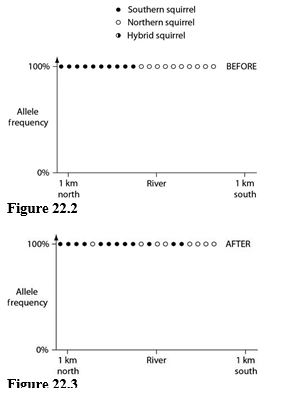
The data in these graphs indicate that
- A) a hybrid zone was established after the completion of the bridge.
- B) there was no migration between the two squirrel populations after the bridge was completed.
- C) gene flow occurred from one type of squirrel into the gene pool of the other type of squirrel.
- D) two-way migration of squirrels occurred across the bridge, but without hybridization.
- E) some northern squirrels migrated south, but no southern squirrels migrated north across the bridge.
D
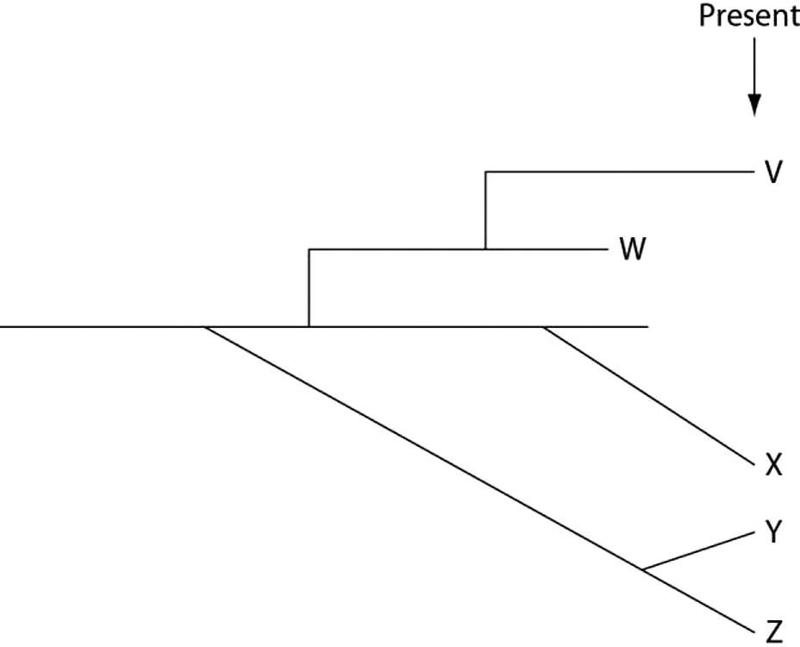
Which species is most closely related to species W?
- A) V is most closely related to species W.
- B) X is most closely related to species W.
- C) Y and Z are equally closely related to W.
- D) It is not possible to say from this tree.
A
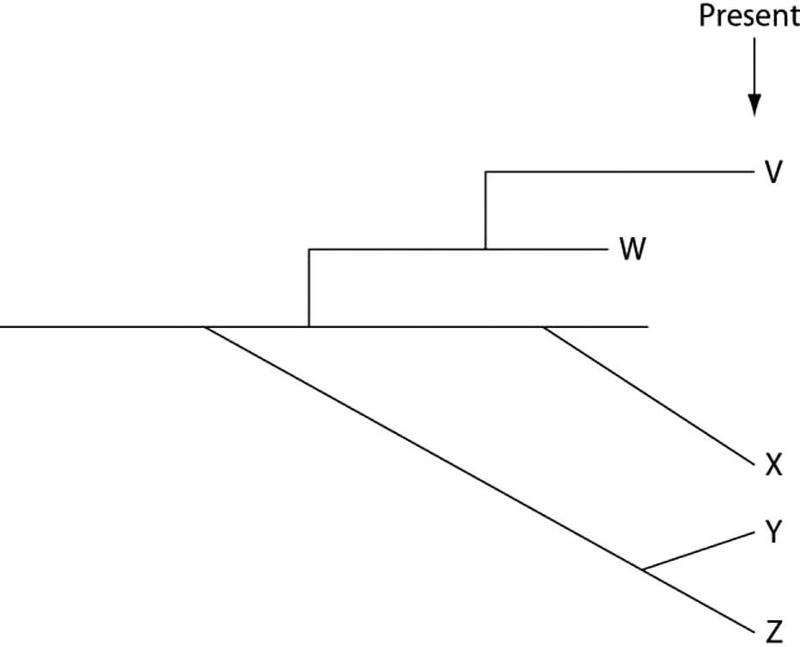
Which species is least expected to have a good record of transitional fossils; in other words, which species' fossils, if present at all, are expected only in relatively superficial (that is, shallow) strata?
- A) V
- B) W
- C) X
- D) Y
- E) Z
A
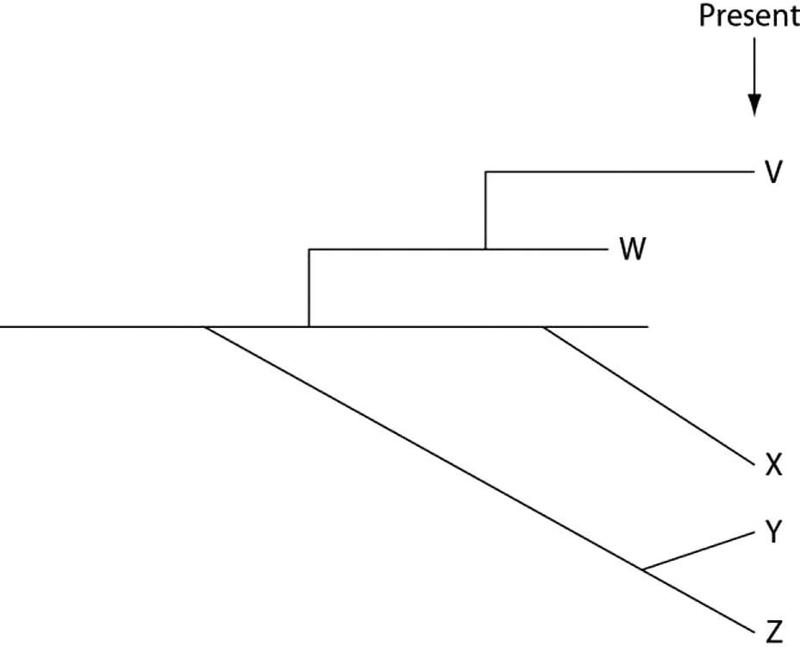
Which of these five species originated earliest and appeared suddenly in the fossil record?
- A) V
- B) W
- C) X
- D) Y
- E) Z
B
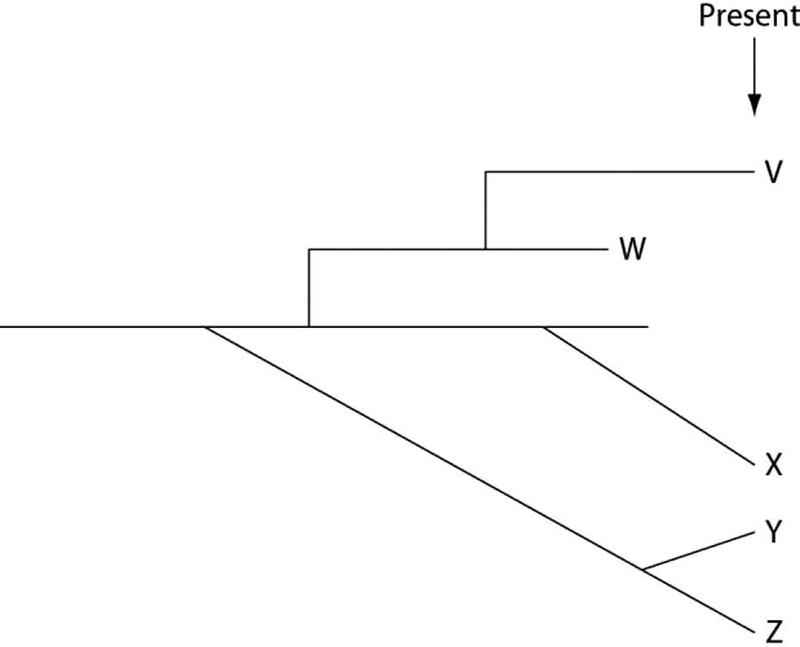
Which conclusion can be drawn from this evolutionary tree?
- A) Gradualistic speciation and speciation involving punctuated equilibrium are mutually exclusive concepts.
- B) Eldredge and Gould would deny that the lineages labeled X, Y, and Z could represent true species.
- C) Assuming that the tip of each line represents a species, there are five extant (that is, not extinct) species resulting from the earliest common ancestor.
- D) A single clade (that is, a group of species that share a common ancestor) can exhibit both gradualism and punctuated equilibrium.
D
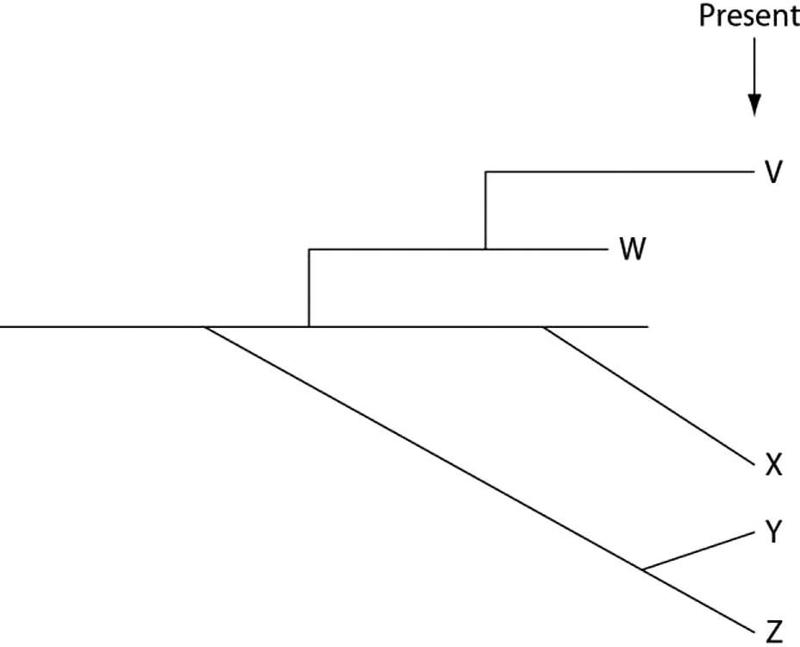
Which of these five species is the extant (that is, not extinct) species that is most closely related to species X, and why is this so?
- A) V; shared a common ancestor with X most recently
- B) W; shared a common ancestor with X most recently
- C) Y; arose before X
- D) Z; shared a common ancestor with X
A
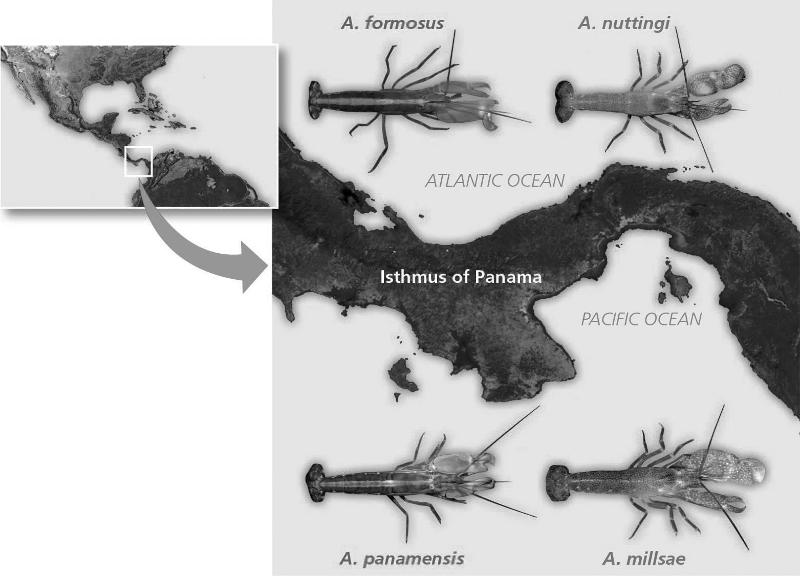
Which of the following is evidence for allopatric speciation by the formation of the Isthmus of Panama?
- A) One species of the sister species lives on the Pacific side.
- B) Genetic analyses indicate time of origin.
- C) Sister species diverge first.
- D) Coordination of geological evidence demonstrated species divergence.
D
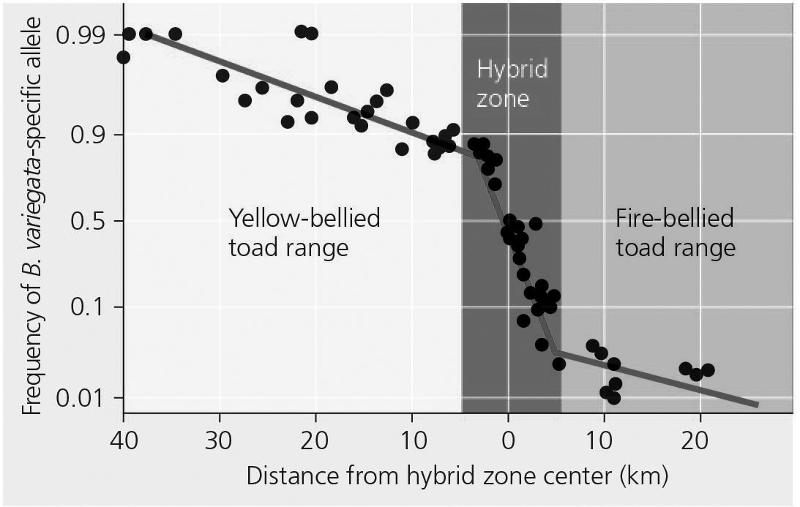
A hybrid zone is indicated by plotting the frequency of the yellow-belly allele across the distance from the center of the hybrid zone. What is the gene frequency of the fire-bellied toad 20 km from the hybrid zone center?
- A) 1
- B) 0
- C) 0.1
- D) 10
C
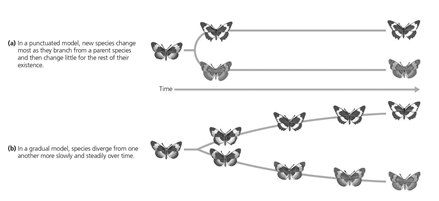
Two models for the speed of speciation are based on patterns in the fossil record. Which of the following statements describes the gradual model of evolution?
- A) Species steadily diverge from one another.
- B) New species change suddenly.
- C) Periods of stasis are punctuated by change.
- D) There is absence of intermediate fossils.
A
On the volcanic, equatorial West African island of Sao Tomé, two species of fruit fly exist. Drosophila yakuba inhabits the island's lowlands and is also found on the African mainland, located about 200 miles away. At higher elevations, and only on Sao Tomé, is found the very closely related Drosophila santomea. The two species can hybridize, though male hybrids are sterile. A hybrid zone exists at middle elevations, though hybrids there are greatly outnumbered by D. santomea. Studies of the two species' nuclear genomes reveal that D. yakuba on the island is more closely related to mainland D. yakuba than to D. santomea (2n = 4 in both species). Sao Tomé rose from the Atlantic Ocean about 14 million years ago.
Which of the following reduces gene flow between the gene pools of the two species on Sao Tomé, despite the existence of hybrids?
- A) hybrid breakdown
- B) hybrid inviability
- C) hybrid sterility
- D) temporal isolation
- E) a geographic barrier
C
On the volcanic, equatorial West African island of Sao Tomé, two species of fruit fly exist. Drosophila yakuba inhabits the island's lowlands and is also found on the African mainland, located about 200 miles away. At higher elevations, and only on Sao Tomé, is found the very closely related Drosophila santomea. The two species can hybridize, though male hybrids are sterile. A hybrid zone exists at middle elevations, though hybrids there are greatly outnumbered by D. santomea. Studies of the two species' nuclear genomes reveal that D. yakuba on the island is more closely related to mainland D. yakuba than to D. santomea (2n = 4 in both species). Sao Tomé rose from the Atlantic Ocean about 14 million years ago.
If a speciation event occurred on Sao Tomé, producing D. santomea from a parent colony of D. yakuba, then which of the following terms applies (apply)?
- macroevolution
II allopatric speciation
III. sympatric speciation
- A) I only
- B) II only
- C) I and II
- D) I and III
D
On the volcanic, equatorial West African island of Sao Tomé, two species of fruit fly exist. Drosophila yakuba inhabits the island's lowlands and is also found on the African mainland, located about 200 miles away. At higher elevations, and only on Sao Tomé, is found the very closely related Drosophila santomea. The two species can hybridize, though male hybrids are sterile. A hybrid zone exists at middle elevations, though hybrids there are greatly outnumbered by D. santomea. Studies of the two species' nuclear genomes reveal that D. yakuba on the island is more closely related to mainland D. yakuba than to D. santomea (2n = 4 in both species). Sao Tomé rose from the Atlantic Ocean about 14 million years ago.
Using only the information provided in the paragraph, which of the following is the best initial hypothesis for how D. santomea descended from D. yakuba?
- A) geographic isolation
- B) autopolyploidy
- C) habitat differentiation
- D) sexual selection
- E) allopolyploidy
C
You find a plant that is larger than others in your wheat field. When you examine the chromosomes of this plant during cell division, you observe that the cells have double chromosome numbers of the other wheat plants. You conclude that this is an autopolyploid plant representing a new biological species in your wheat field when you observe
- A) fertile tetrapods produced by self-pollinating.
- B) production of hybrid organisms.
- C) allopolyploids interbreeding with parents.
- D) ancestral sterile plants.
A
The observation that island D. yakuba are more closely related to mainland D. yakuba than island D. yakuba are to D. santomea is best explained by proposing that D. santomea
- A) descended from a now-extinct non-African fruit fly.
- B) arrived on the island before yakuba.
- C) descended from a single colony of yakuba, which had been introduced from elsewhere, with no subsequent colonization events.
D) descended from an original colony of D. yakuba, of which there are no surviving members
D
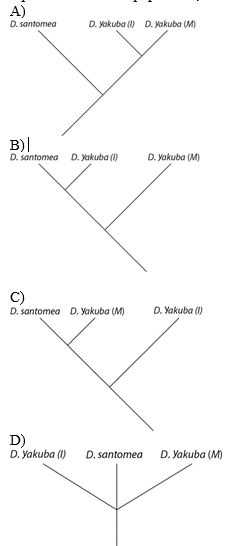
Which of these evolutionary trees represents the situation described in the previous paragraph? (Note: D. yakuba (I) represents the island population, and D. yakuba (M) represents the mainland population.)
A
If the low number of hybrid flies in the hybrid zone, relative to the number of D. santomea flies there, is due to the fact that hybrids are poorly adapted to conditions in the hybrid zone, and if fewer hybrid flies are produced with the passage of time, these conditions will most likely lead to
- A) fusion.
- B) reinforcement.
- C) stability.
- D) further speciation events.
B
On the Bahamian island of Andros, mosquitofish populations live in various, now-isolated, freshwater ponds that were once united. Currently, some predator-rich ponds have mosquitofish that can swim in short, fast bursts; other predator-poor ponds have mosquitofish that can swim continuously for a long time. When placed together in the same body of water, the two kinds of female mosquitofish exhibit exclusive breeding preferences.
Which type of reproductive isolation operates to keep the mosquitofish isolated, even when fish from different ponds are reunited in the same body of water?
- A) behavioral isolation
- B) habitat isolation
- C) temporal isolation
- D) mechanical isolation
- E) gametic isolation
A
On the Bahamian island of Andros, mosquitofish populations live in various, now-isolated, freshwater ponds that were once united. Currently, some predator-rich ponds have mosquitofish that can swim in short, fast bursts; other predator-poor ponds have mosquitofish that can swim continuously for a long time. When placed together in the same body of water, the two kinds of female mosquitofish exhibit exclusive breeding preferences.
Which two of the following have operated to increase divergence between mosquitofish populations on Andros?
- improved gene flow
- bottleneck effect
- sexual selection
- founder effect
- natural selection
- A) 1 and 3
- B) 2 and 3
- C) 2 and 4
- D) 3 and 4
- E) 3 and 5
E
On the Bahamian island of Andros, mosquitofish populations live in various, now-isolated, freshwater ponds that were once united. Currently, some predator-rich ponds have mosquitofish that can swim in short, fast bursts; other predator-poor ponds have mosquitofish that can swim continuously for a long time. When placed together in the same body of water, the two kinds of female mosquitofish exhibit exclusive breeding preferences.
What is the best way to promote fusion between two related populations of mosquitofish, one of which lives in a predator-rich pond, and the other of which lives in a predator-poor pond?
- A) Build a canal linking the two ponds that permits free movement of mosquitofish, but not of predators.
- B) Transfer only female mosquitofish from a predator-rich pond to a predator-poor pond.
- C) Perform a reciprocal transfer of females between predator-rich and predator-poor ponds.
- D) Remove predators from a predator-rich pond and transfer them to a predator-poor pond.
A
If one builds a canal linking a predator-rich pond to a predator-poor pond, then what type of selection should subsequently be most expected among the mosquitofish in the original predator-rich pond, and what type should be most expected among the mosquitofish in the formerly predator-poor pond?
- A) stabilizing selection; directional selection
- B) stabilizing selection; stabilizing selection
- C) less-intense directional selection; more-intense directional selection
- D) less-intense disruptive selection; more-intense disruptive selection
C
The predatory fish rely on visual cues and speed to capture mosquitofish. Mosquitofish rely on speed and visual cues to avoid the predatory fish. Which adaptation(s) might help the predators survive in ponds that are home to faster mosquitofish?
- directional selection for increased speed
- stabilizing selection for speed that matches that of the mosquitofish
- change in hunting behavior that replaces reliance on visual cues with reliance on tactile cues
- change in hunting behavior that eliminates speed in favor of better camouflage, which permits an ambush strategy
- A) 1 only
- B) 2 only
- C) either 1 or 3
- D) 1, 3, or 4
D
In the ocean, on either side of the Isthmus of Panama, are 30 species of snapping shrimp; some are shallow-water species, and others are adapted to deep water. There are 15 species on the Pacific side and 15 different species on the Atlantic side. The Isthmus of Panama started rising about 10 million years ago. The oceans were completely separated by the isthmus about 3 million years ago.
Why should deepwater shrimp on different sides of the isthmus have diverged from each other earlier than shallow-water shrimp?
- A) They have been geographically isolated from each other for a longer time.
- B) Cold temperatures, associated with deep water, have accelerated the mutation rate, resulting in faster divergence in deepwater shrimp.
- C) The rise of the land bridge was accompanied by much volcanic activity. Volcanic ash contains heavy metals, which are known mutagens. Ash fall caused high levels of heavy metals in the ocean sediments underlying the deep water, resulting in accelerated mutation rates and faster divergence in deepwater shrimp.
- D) Fresh water entering the ocean from the canal is both less dense and cloudier than seawater. The cloudy fresh water interferes with the ability of shallow-water shrimp to locate mating partners, which reduces the frequency of mating, thereby slowing the introduction of genetic variation.
A
The largest unit within which gene flow can readily occur is a
- A) population.
- B) species.
- C) genus.
- D) hybrid.
B
Males of different species of the fruit fly Drosophila that live in the same parts of the Hawaiian Islands have different elaborate courtship rituals. These rituals involve fighting other males and making stylized movements that attract females. What type of reproductive isolation does this represent?
- A) habitat isolation
- B) temporal isolation
- C) behavioral isolation
- D) gametic isolation
C
According to the punctuated equilibria model,
- A) natural selection is unimportant as a mechanism of evolution.
- B) given enough time, most existing species will branch gradually into new species.
- C) most evolution occurs in sympatric populations.
- D) most new species accumulate their unique features relatively rapidly as they come into existence, then change little for the rest of their duration as a species.
D
Bird guides once listed the myrtle warbler and Audubon's warbler as distinct species. Recently, these birds have been reclassified as eastern and western forms of a single species, the yellow-rumped warbler. Which of the following pieces of evidence, if true, would be cause for this reclassification?
- A) The two forms interbreed often in nature, and their offspring survive and reproduce well.
- B) The two forms live in similar habitats and have similar food requirements.
- C) The two forms have many genes in common.
- D) The two forms are very similar in coloration.
A
Which of the following factors would not contribute to allopatric speciation?
- A) A population becomes geographically isolated from the parent population.
- B) The separated population is small, and genetic drift occurs.
- C) The isolated population is exposed to different selection pressures than the ancestral population.
- D) Gene flow between the two populations is extensive.
D
Plant species A has a diploid number of 12. Plant species B has a diploid number of 16. A new species, C, arises as an allopolyploid from A and B. The diploid number for species C would probably be
- A) 14.
- B) 16.
- C) 28.
- D) 56.
C